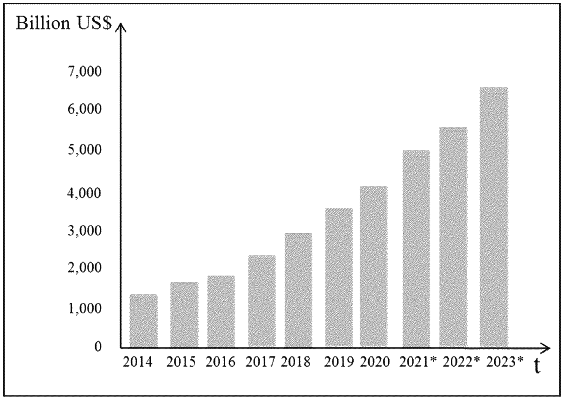| CPC G06Q 10/0832 (2013.01) [B64D 1/12 (2013.01); B64D 1/14 (2013.01); B64D 9/00 (2013.01); B64F 1/32 (2013.01); B64F 1/322 (2020.01); B65D 21/0213 (2013.01); G05D 1/0094 (2013.01); G05D 1/105 (2013.01); G06F 17/11 (2013.01); G06Q 10/06315 (2013.01); G06Q 10/08 (2013.01); G06Q 10/08355 (2013.01); G06Q 10/087 (2013.01); G06Q 30/0635 (2013.01); G06Q 50/28 (2013.01); B64C 39/024 (2013.01); B64U 2101/60 (2023.01); B64U 2201/10 (2023.01); G05B 2219/50391 (2013.01); G06Q 50/30 (2013.01)] | 52 Claims |

|
1. A low capital and operation cost e-commerce first mile logistics method comprises the use of multibox packages, sorting at the origin, and air-cargos that are air-dropped, and that allows for the fast and massive delivery of e-commerce merchandise in an extensive geographical area, reducing the need for building, operating, or using a large number of fulfillment centers located near the consumers as in traditional e-commerce de-centralized logistics, comprising the following steps:
a) Providing a computing system that receives fulfillment information of an order for e-commerce merchandise placed through at least one of an online shopping platform or a consumer, where the computing system is capable of receiving at least 1,000 orders per day and is in network connection or communication with at least one Central Fulfillment Center (CFC) (2) having a storage area of at least about 5,000 m2, a height of at least two meters from a floor and a top-most roof of the facility, and that is configured to store at least 10,000 items of e-commerce merchandise, wherein the CFC (2) is located at a distance of no more than 50 km from a runway facility for at least one of take-off or landing of a manned aircraft, and wherein the CFC (2) replaces at least a 20% of the total fulfillment center space used in a traditional de-centralized logistics model;
b) Selecting, sorting, and preparing, based on the fulfillment information received by the computing system, the merchandise as at least one of a multibox package (41), wherein the at least one multibox package (41), is then configured or prepared as part of at least one air-cargo (43), and loading the at least one air-cargo (43) into a manned air drop delivery aircraft (5) that is capable of carrying a total air-cargo load of at least 2,000 kgs in average and capable of flying at a speed of at least 200 km/h, wherein the merchandise is sorted by a sorting system at the origin CFC to prepare the at least one multibox package that houses such merchandise based on the final destination zone (such as a block, neighborhood, small town, small city, and even a same building, among others); and wherein the least one multibox package (41) contains products from more than one order or consumer, where such products or orders are destined to a same predefined final destination zone;
c) Determining, based on the fulfillment information of the e-commerce merchandise within the air-cargo, a drop zone (8) to where the at least one air-cargo (43) should be air-dropped so that the air-cargo (43) lands within such drop zone (8);
d) Providing at least one landing assisting system (9) configured to reduce the landing speed of the air-cargo and/or providing a softer landing of the at least one air-cargo (43) within the drop zone (8), wherein the landing assisting system (9) comprises a net receiving system (91) with a surface of at least about 200 m2 and an air-cargo receiving capacity of at least 10 air-cargos per hour, and wherein the net receiving system comprises at least one impact assist system that includes at least one of a force dissipation device or a deceleration system;
e) Air-dropping at least one air-cargo (43) from the aircraft (5) so that the air-cargo (43) lands within the drop zone (8), wherein the air-cargo is ejected from the aircraft (5) at an altitude of between 5 m and 20,000 m, and at a speed depending on the type of aircraft, environmental or weather conditions, type of landing assisting system (9) or path guidance system (10) used, regulatory requirements, or safety requirements, among others;
f) Receiving the air-cargo in at least one drop zone (8), wherein the air-cargo lands within the drop zone or within a landing assisting system (9) used as part of the drop zone (8), and collecting the air-cargo from within the drop zone; and
g) Delivering the e-commerce merchandise to the consumer from the drop zone (8), wherein the merchandise can go through an outbound sorting center (14) prior to delivery to the consumer, wherein the delivery process can utilize last mile delivery systems;
wherein the method allows to sort and transport e-commerce merchandise from its storage location to a final logistic point that is close to the consumer, and from where the last mile delivery process is performed; and
wherein the method is configured to achieve a Low-Cost Logistics Efficiency Index of at least 100, as defined by the equation below:
 where:
nCFC is the total number of CFCs (2) utilized with the low capital and operation cost logistics method;
nP is the total number of packages delivered per day through air-drop delivery;
WAD is the average weight of the air-cargo that is delivered through air-drop delivery in kg;
VAD is the average air-drop velocity of the air-cargo in km/h;
d is the average distance that the air-cargo (43) travels from a CFC (2) and/or transfer airport (12) to its target drop zone;
nC is the average number of different consumers that receive the merchandise; and
WIAD is a binary index relating to the average weight of the air-cargo (43) that contains the e-commerce merchandise and that is air-dropped from aircraft (5), and is a binary number as calculated below:
 VIAD is an index relating to the average velocity that the air-cargo (43) that contains the e-commerce merchandise is dropped from the aircraft (5) during the air-drop delivery, and is a binary number as calculated below
 |